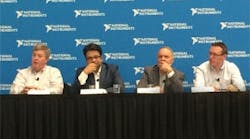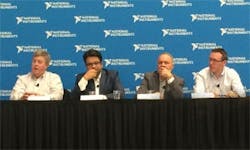Each summer, National Instruments (NI) does its best to raise the automation bar just a little higher as its devoted customer base gathers in Austin, Texas, for a week of what’s new. The atmosphere is a cross between a high-tech maker fair and a pep rally for innovation and invention. Sparks fly. Ideas blossom. Engineering problems lie solved and trampled among the footprints of participants and speakers.
Figure 1: Analog Devices' Leo McHugh, AT&T Labs' Arun Ghosh, Real-Time Innovations' Stan Schneider and Valeo's Derek O'Dea discuss the future of engineering and connectivity at NIWeek in Austin, Texas.
Of course, this year, data, connectivity and virtual simulation held most of the attention at NIWeek, and four of the main-stage presenters assembled for a lunchtime panel discussion of where we’re headed and what we’ll engineer next (Figure 1).
“Not too long ago, you could walk into a customer and hand them a bag of components and say, ‘Have at it,’ and they had people who could put together systems from individual components,” explained Leo McHugh vice president of instrumentation, aerospace & defense, at Analog Devices. “Everyone these days wants a system put together from a subsystem approach. They want the hardware with some of the software; they want a black box. It comes down to time. Time is a differentiator. Nobody has the time to spend starting where they used to start. We’re moving into more modules. Think about it as a change in the platform dimensions. You don’t have to worry about what’s in the solution. You just use it.”
The biggest challenge has been to shed the old ways of doing things, said Arun Ghosh, director, advanced wireless technologies, AT&T Labs. “Now, you get an iPhone at the store, and you turn it on, and it works,” he explained. “We’ve gotten to real systems that are extremely dynamic, where a lot of optimization can be done.”
5G is coming, and it’s coming fast, predicted Ghosh. “We started working on LTE (long-term evolution) technology in 2005, and we deployed the technology in 2011,” he explained. “With 5G, we’re shrinking the time scale from six years to barely two-and-a-half years. The way it’s being designed it’s tightly integrated with our LTE network as an add-on. People don’t want components. They want integrated systems. These are interesting times. There’s opportunity for a lot of innovation.”
There’s a huge opportunity to change the way the world works, proclaimed said Stan Schneider, CEO of Real-Time Innovations (RTI) and steering committee member of the Industrial Internet Consortium (IIC). “It’s a new world out there, and the connectivity enables the applications,” he said.
“The Industrial Internet of Things (IIoT) has become code for the entire future of technology, and there are two camps behind it—the killer app and the analytics,” explained Schneider. “For example, the first Internet connected people’s computers together to get the killer app called email. The IIoT is the analytics side, a very different application.”
IT people see data like the New Yorker cover of Saul Steinberg’s View of the World From 9th Avenue, explained Schneider. “There’s the IT network, and the edge is everything else,” he said.
Virtual vehicles
Valeo is a Paris-based Tier 1 automotive supplier of smart technology for emission reduction and intuitive driving. “I work in Ireland,” said Derek O’Dea, Valeo’s measurement and tools group manager, “where we focus on surround-view cameras and automated parking systems. These are becoming everyday systems now, and the traditional two-year development cycle has started to erode. The amount of software going into cars is increasing hugely, and the requirements of the system are dynamic; they’re changing as we go, which makes it difficult for us to develop test systems in that situation.”
Typically, for testing, Valeo will deploy National Instruments’ PC-based PXI system in the vehicle and connect all of the sensors and then drive the car in real-world situations. “We generate that big data and then bring it back for training and validation in our functions later,” explained O’Dea. Then those algorithms go into the controller that’s deployed in the vehicle. The PXI system switches roles so the data is injected back into the device under test, so the performance of the controls can be tested on the bench in a hardware-in-the-loop (HIL) system. “Road testing is great, but it’s huge in cost and time, and there are a lot of limitations, so you have to do some of the testing in a virtual world, as well. We use simulation and generate virtual environments for safety aspects,” said O’Dea.
“We create a virtual car running inside a virtual environment with virtual sensors on the car,” explained O’Dea. “And those virtual sensors generate data as if it were coming from a real vehicle. We inject that into our electronic control unit (ECU), so we can run thousands and thousands of tests overnight. We can test safety-critical types of situations. We can test pedestrian-intersection functions, so, if a cyclist gets run over, I don’t get arrested. To train the function, you need to capture the data and take it and put it in the cloud.” Valeo is constantly capturing data, approximately 40 GB/minute, said O’Dea.
“There’s data, and then there’s useful data,” explained Schneider. “You can search a database for what you want. We’re in several production-track ‘carbots,’ and there are tons of data coming from them. They’re even tracking what the people in the car are doing. You’ve got terabytes of useless data, but the car can subscribe to things like any item moving toward me within so many meters.”
The usefulness of the data is more important than the volume of the data, said Schneider. “The big problem isn’t the amount of data,” he explained. “It’s the valuable data that’s stuck in all of that data. For control systems, it’s getting the right data in the right place at the right time.” There’s phenomenal value in knowing ahead of time what you care about.
“Software is eating the world,” said Schneider. “I see the IT/OT convergence as a horizontal thing. Machine learning has come to mean everything. Deep learning is an algorithm; it’s a training set. The process of getting those training sets is hugely expensive. You need a human to say, for example, ‘That’s a pedestrian.’ We’re very early in this game.”
Valeo gets data for machine learning by generating code to communicate with cameras and extract images from the camera the very first time the camera’s brought up. “We reuse that code downstream, right from the first bringing up of the camera through the design-and-validation stage right through to full-scale production,” explained O’Dea. “Typically, we reuse about 80% of the actual software that we develop. And from the hardware perspective, for the cameras, we use the National Instruments FlexRIO system. We build a new adapter module per camera. That’s all we change.”
O’Dea has built a team with strong experience in National Instrument’s LabView platform, which allows them to focus on development. “The guys can focus on FPGA programming,” he explained. “They can focus on capturing from the vehicles. They can focus on the HIL systems, the benchtop systems and right through to full-scale production. This means I don’t have to be hiring VHDL developers or C++ developers. And the developers themselves can be changing from one task to another from day to day. They can be programming an FPGA one day. They can be programming GUIs for in-vehicle capture systems the next day.”
There are systems, and then there are systems
“What is a system?” asked RTI’s Schneider. “You have to have a definition of a system.” Is it a chip? Is it a group of computers networked together?
“The earlier you start something the earlier you can get it done,” said Analog Devices’ McHugh. “We need customers to decide what they want. The time-to-market stage is critical to many projects. We reuse what we can. If you look at our evaluation lab and test development, they’re working on different aspects of the same project. Let’s define what the requirements are up front and see what the best way is to distribute those. A lot of code reuse goes on. Going back to Stan Schneider’s question—what is a system? It changes when you start to develop more of the solution. Are you going to give us an algorithm? Many customers want some sort of starting point. It’s not really about bits; it’s about how you use it.”
No matter how modular or how much code can be reused, moving data on the network remains critical to data use and reducing time to market.
“We have to build the network with a high degree of reliability and latencies that are 1 millisecond,” said AT&T’s Ghosh. “That’s what the 5G network is supposed to become. That’s the vision of where we want to take that.”
Radio-access technology provides connectivity between the core network and remote devices or machines. “Most of the entities in the core are virtualized,” explained Ghosh. “The radio-access network is split into real-time functions and non-real-time functions, which has a huge impact on the cost curve.”
ALSO READ: NIWeek speakers take on big analog data and the Industrial Internet of Things
Mike Bacidore is the editor in chief for Control Design magazine. He is an award-winning columnist, earning a Gold Regional Award and a Silver National Award from the American Society of Business Publication Editors. Email him at [email protected].






